|
|
|
|
The 1955-S Damaged Die
Scenario
by Ken Potter - NLG
© Ken Potter 2004
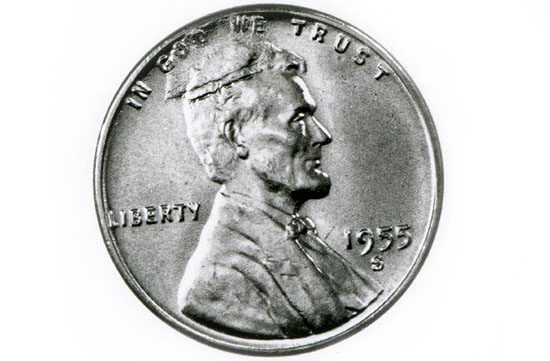
Macro photo courtesy of Marilyn Van Allen
One of the more interesting examples of die damage that
we've seen on a US coin is found on the 1955-S cent. I first became aware of it back
in the early 1980s when a New York collector asked if I had one in stock as he was
assembling a collection of error coins dated 1955-S and needed one. Shortly
after, I located one and the transaction was made. I figured I'd never see another as
the word out on the variety was that it was nearly as scarce as hen's teeth.
However, as luck would have it, some time around the late 1980s/early
1990s, fellow errorist Chuck Avery of Michigan purchased a half bag and a full bag of
uncirculated 1955-S cents, both with a serious vein of these varieties hidden
within. As I remember it, the bags were purchased coincidentally at just about the same
time from two different fellows living in Michigan about 50 miles apart. As luck
would have it, Chuck searched the bags for errors and varieties and found over 100
examples of this variety between both! After selling a few off locally, Chuck
offered to sell me the balance which came out to exactly 100 coins which needless to say
ended up in my stock.
Now, with 100 coins in stock and over a dozen years passing since
I've been handling them, you'd think I'd have gotten tired of the variety. Such is not the
case. As simple as it may be, I am still as fascinated by the story behind the coin
today as I was the first time I laid eyes on it. I enjoy looking at one of these babies
every time I handle one!
So lets take a closer look. In the first image below we see a die
crack that runs from rim to rim with a noticeable die break near the upper end. A
die crack of this sort (with or without the intervening die break) is what some call a
pre-cud die crack. This one was found in a bag along with several specimens of our
subject coin by George Schaetzle of Tennessee in 1996.
In the second photo we see what started out as a simple rim to
rim die crack (and die break) has indeed developed into a major die break or what others
affectionately refer to as a "Cud." Specifically, the die crack has broken
the rest of the way into the interior of the die, with the small section of die within the
confines of the crack and rim separating completely from the main die face and
shank. With this section of die now missing, the die will strike coins with a
"blob" in that area representing the cavity that was left behind by
the wayward chuck of die. Metal will simply flow up into it as far as the pressure
of the dies will allow and remain unstruck.
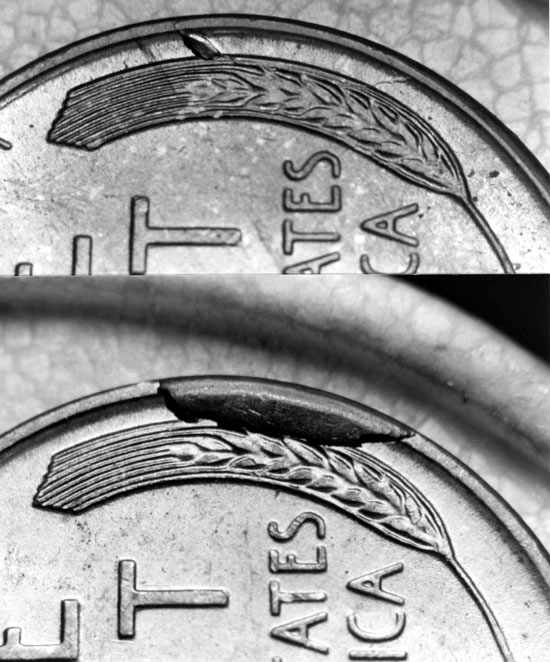
Photos by & © Ken Potter 1996
Now for most cuds this is the beginning and end of the
story but for this one we're just getting started on relating what will become an even
more interesting feature to the coin than just the cud.
Instead of the wayward chunk of die just falling away, (as is typically
the case), it somehow worked its way in between the dies. Perhaps as it was falling
away it hitchhiked a ride back into the dies on an incoming planchet? We'll never
know for sure exactly how it got there but in fact it did. As a result, when the dies came
down to strike the next coin, that little chunk of broken die was struck too and managed
to effect significant damage to both the obverse and reverse dies.
I theorize that it was most probably transported between the dies on
top of a planchet as it appears to me that the damage to the obverse die is far more
extensive than on the reverse. My guess is that the obverse took the brunt of the
damage while the reverse die was protected partially by the planchet through which the
chuck of die was undoubtedly driven to impart as least some damage to the reverse
die. This is of course just one scenario and in truth this may not be the
exactly how it happened. We can almost be sure that the inner section of the die,
which would have presumably left a granular scar, was probably quite flat and more easily
pushed into the upper die (were we see the granular damage with striations) than the outside shank area of
that chuck of die. The shank section would have been smooth and rounded and perhaps had to be
struck flatter before it could even start to effect as much damage. As such, it is
possible that the dies came down together without a planchet in between and the
differences in the severity of the damage between obverse and reverse is due to the
placement and shape of the chunk of die. What we can reasonably conclude with a degree of
certainty is that the broken piece of die is what undoubtedly caused the damage.
In the two photos below we see the effect of the damage to the obverse
"capping" Lincoln's head and effacing portions of GOD WE of IN GOD WE
TRUST. Notice the granular effect that we suggest is an indicator of the inner
"core" side of the piece of die impacting the obverse. On the reverse we see a
severe dent running diagonally from the lower OF of UNITED STATES OF AMERICA and reaching
toward the right wheat stem. We also see the damage was extensive enough to
flatten the wheat stem on the left. Notice there is no sign of granularity on this
area of die damage.
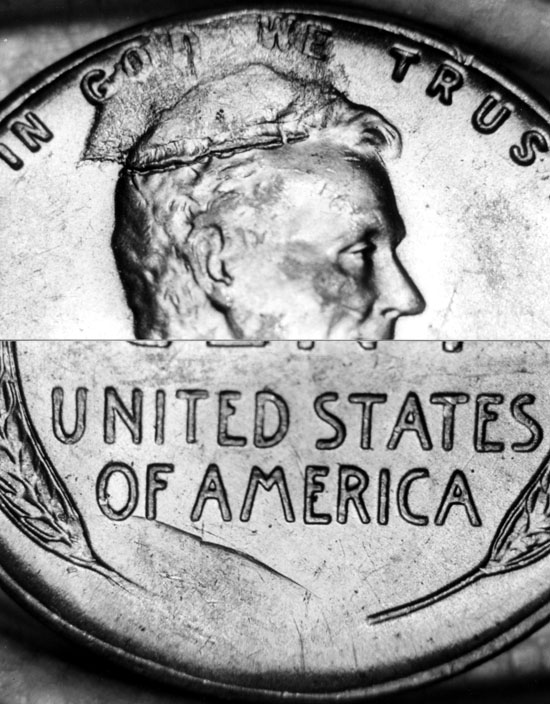
Photos by & © Ken Potter 1996
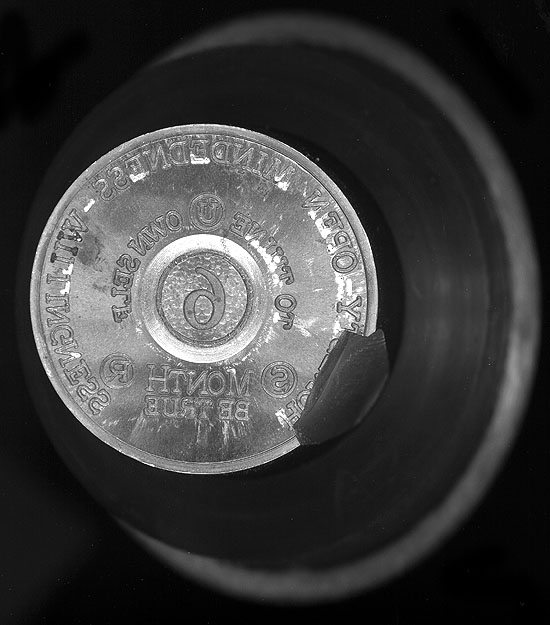
Here is a top view of a "cud" on a token die undoubtedly similar
to the one that was on the 1955-S cent die
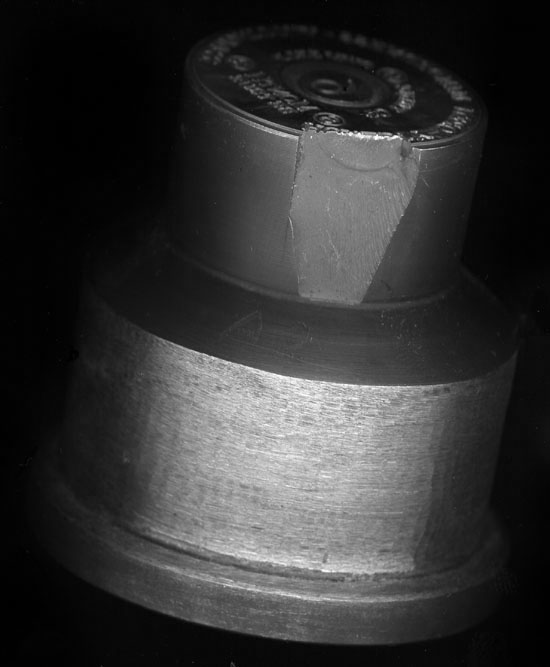
Side view of same token die shows how cuds typically break from
the face and down along the shank or nose of the die
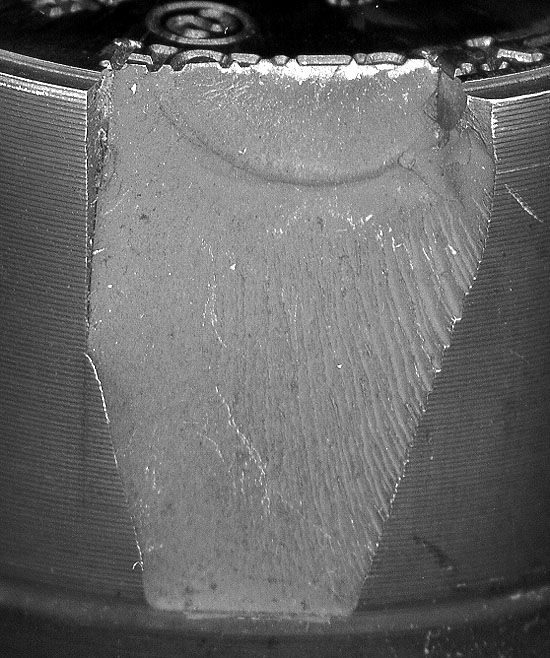
Close up detail of token die
Token die images by & © Ken Potter 2004
Send email to: KPotter256@aol.com
|
|